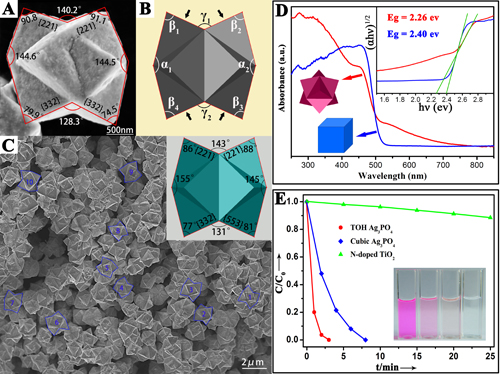The design and synthesis of semi-conduct photo-catalytic materials and study on their facet control have become hot topics in field of photo-catalysis. However, currently reported heterogeneous materials have certain shortcomings resulting from their morphological and structural defects, including low photo-induced charge separation efficiency and low catalytic activity under visible light. Thus, the design and preparation of photocatalytic nanomaterials with highly efficient electron-hole separation structure, and controlled synthesis of facets with high activity have been problems to be urgently solved.
The energy and nano catalytic materials for environment research group at the Lanzhou Institute of Chemical Physics (LICP), Chinese Academy of Sciences (CAS), have been long engaged in the study on Ag3PO4 structures and their photo-catalytic performance. They have developed several facile methods for the fabrication of Ag3PO4 structures with excellent photo-catalytic performance.
Firstly, the group has demonstrated selective growth of Ag3PO4 submicro-cubes on Ag nanowires to construct necklace-like hetero-photocatalysts. This novel hetero-structure exhibits much higher activity than both pure Ag3PO4 cubes and Ag nanowires for degradation of organic contaminants under visible light irradiation, which may be primarily ascribed to highly efficient charge separation at the contact interfaces as well as rapid electron export through Ag nanowires. The work has been published inJ. Mater. Chem.(J. Mater. Chem.2012, 22, 14847). Then they have demonstrated that metallic Ag nanocrystals can be selectively formed on the entire surface, edges and partial {100} facets, or only edges of single-crystalline Ag3PO4 submicro-cubes by simply adjusting the concentrations of ammonia. The work has been published in Chem. Eur. J.(Chem. Eur. J.2012, 18, 14272).
After they have prepared Ag3PO4 sub-microcubes with exposed {100} facets, they have further deepened the study. They have fabricated tetrahedral Ag3PO4 submicro-crystals in high yield by directly reacting commercial Ag foils with H2O2 and NaH2PO4 in aqueous solution at room temperature. These tetrahedral Ag3PO4 exhibited much higher photocatalytic activities than the irregular and cubic Ag3PO4 nanocrystals and commercial N-doped TiO2 under visible-light irradiation. The work has been published in J. Mater. Chem. A (J. Mater. Chem. A2013,1, 2387) and Phys. Chem. Chem. Phys.(Phys. Chem. Chem. Phys.2012,14,14486).
Recently, they have demonstrated for the first time the fabrication of concave trisoctahedral Ag3PO4 microcrystals enclosed by {221} and {332} facets based on the heteroepitaxial growth procedure, which exhibit much higher photocatalytic activities than cubic Ag3PO4 and commercial N-doped TiO2. With density functional theory (DFT) calculations, researchers have found that Ag3PO4 {221}
 |
| SEM image, UV-vis diffusive reflectance spectra and photocatalytic activities of trisoctahedral Ag3PO4microcrystals. (Imagy by BI Yingpu et al.) |
The work has received support from the National Natural Science Foundation of China.


